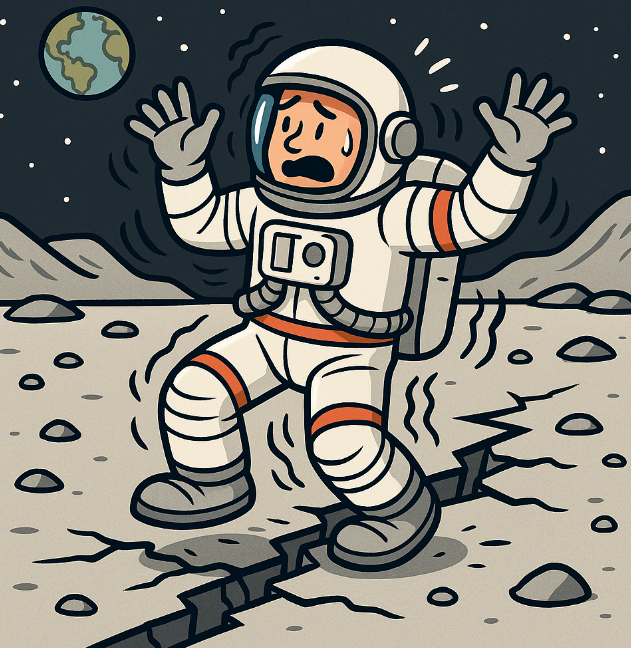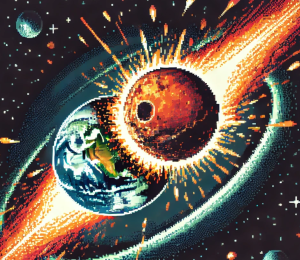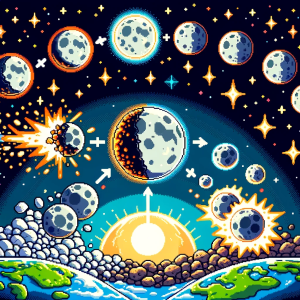
Moonquakes Can Launch 15-Ton Boulders
Here’s a wild thought: the Moon isn’t the dead, silent rock we once believed it to be. It shudders. It slips. It even tosses boulders down its slopes like a petulant child flipping over toy blocks. And thanks to a recent study, we now have concrete—well, lunar regolith—evidence of this surprisingly active behavior.
This isn’t sci-fi. It’s hard science, pulled from real boulders examined by the Apollo 17 astronauts over 50 years ago—and only now fully understood.
Moonquakes Are Real. And They Pack a Punch.
Back in 1972, astronauts Eugene Cernan and Harrison Schmitt weren’t just collecting rocks in the Taurus-Littrow Valley. Unbeknownst to them, they were standing in a seismic danger zone. Nestled among towering lunar mountains, the valley is home to a fault line called the Lee-Lincoln Scarp.
Now, a 2025 study analyzed how four big boulders and a massive landslide came to rest in their current locations—and all signs point to shallow moonquakes as the culprit. That’s right: the Moon trembles hard enough to send rocks tumbling and entire slopes collapsing.
Let’s Talk About Those Tumbling Boulders
Some of these rocks are the size of a school bus. One particularly beefy boulder at Apollo Station 6 measured 15 meters long and 8 meters wide. These weren’t gently nudged downhill by a breeze (the Moon doesn’t even have air). It took serious ground shaking to jolt them free.
The researchers ran simulations to figure out how much shaking would be needed to trigger the falls. Turns out, the Moon experienced ground accelerations up to 2.1 m/s²—more than 10% of Earth’s gravity, and sometimes even rivaling it.
Even cooler? By analyzing the cosmic radiation exposure on these boulders, scientists could date when they tumbled—some as recently as 17 million years ago, others as far back as 90 million years. In geological terms, that’s practically yesterday.
How Do You Cause a Moonquake?
On Earth, most earthquakes are caused by tectonic plate movement. But the Moon doesn’t have tectonic plates. So what’s going on?
It comes down to the Moon slowly shrinking. Yes, like a wrinkling apple. As it cools, its interior contracts, squeezing the crust and forming thrust faults—cracks where one side pushes over the other. When these faults slip suddenly, they generate moonquakes.
The Lee-Lincoln fault near the Apollo 17 landing site is one of thousands of such faults crisscrossing the Moon. And it’s still growing.
Could Moonquakes Threaten Future Moon Bases?
Short answer: potentially. The same shaking that dislodged ancient boulders could rattle future lunar habitats.
The study modeled what would happen if a quake struck near a modern lunar lander. A large moonquake—say, magnitude 3.0—could produce enough force to tip over a spacecraft, especially one as tall as SpaceX’s proposed Starship (about 50 meters high). That’s not a hypothetical risk. The researchers even calculated that if a quake like this had hit during Apollo 17, the lander might’ve been pushed past its stability threshold.
The odds of that happening during a short mission are tiny—roughly 1 in 20 million per day. But for long-term settlements? NASA, take note.
A Paleoseismic Time Machine Made of Regolith
Here’s the brilliant part: by using cosmic ray exposure dating, slope angles, and rock shapes, scientists can reverse-engineer the strength of ancient moonquakes. Each fallen boulder is like a frozen data point. The slope it came from, the size of the rock, and the angle it was resting on all offer clues about the quake that nudged it.
It’s a little like forensic science, but instead of solving crimes, we’re solving planetary mysteries.
What You Thought You Knew…
If you were taught the Moon is geologically dead, think again. It may not be spewing lava, but it’s certainly twitching. And those twitches can have dramatic consequences—collapsing hillsides, flinging boulders, and potentially toppling high-tech habitats.
It also suggests we’ve only scratched the surface (literally) in understanding lunar hazards.
Let’s Explore Together
The Moon isn’t just a dusty relic—it’s a dynamic world with stories written in rockfalls and landslides. And if we plan to live there, we’d better start reading.
What would you do with this discovery?
How do you see this research affecting your view of the Moon?
What’s the coolest science fact you’ve learned recently?
Drop your thoughts in the comments or share this story with your fellow Moon geeks. After all, who knew rocks could tell seismic secrets?



